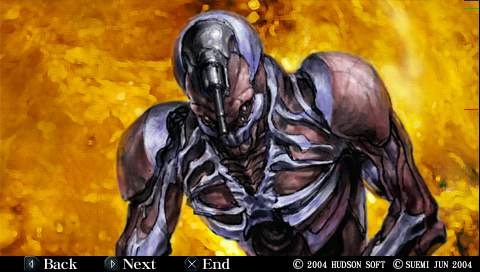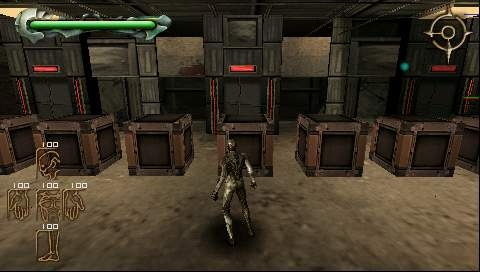On paper it all sounds good: You control a rogue battle android named A.D.A.M., and you clash with other androids, increasing in power as you fight, as well as attaching the weapons of felled enemies to your own robotic chassis. It's nothing too original, but the potential's there for a fun, fast-paced experience that's brimming with robot death. Rengoku: Tower of Purgatory all but completely botches the execution, delivering an experience that's clumsy, repetitious, and, thankfully, fairly short-lived.

There's a loose narrative thread in Rengoku, but the game relies more on a particular strain of Japanese quasi-spiritualism--the kind that prompts anime robots to spout five-minute monologues about the essence of the soul and the meaning of life--to establish atmosphere. Thankfully it's used quite sparingly, manifesting itself mostly in short bits of poorly translated dialogue before a boss fight. All this freshman navel-gazing takes itself rather seriously, but whatever. You're here to murder robots, right?
Then we've got some good news and some bad news. The good news is: You will murder plenty of robots while playing Rengoku: Tower of Purgatory. In fact, aside from customizing A.D.A.M.'s weapon loadout, murdering robots is all you'll do in Rengoku: Tower of Purgatory. The bad news is: Rengoku: Tower of Purgatory all but completely fails to capitalize on the promising prospect of murdering robots all day with its awkward controls and a tedious overall design. Each level in Rengoku is made up of a series of interconnected, randomly generated rooms, and each room encounter goes something like this: Enter a brown room, lock on to the nearest robot, and mash on your attack buttons while double-tapping the D pad to circle-strafe the enemy robot until one of you is dead. Then rinse, and repeat.
The game never throws a large number of opponents at you at once, but you'll regularly encounter other androids that are simply tougher than you. Then you'll either die, at which point you'll have all your equipped weapons stripped from you, and you'll be returned to the beginning of the level, or you'll run back to the start with your tail between your legs. The combat doesn't rely too heavily on skill, so when you do find yourself outmatched, the only real option is to backtrack to an earlier level to grind out more experience fighting weaker opponents. Combine this with the fact that neither the levels nor the enemies you encounter ever change in an appreciable manner, and the whole game becomes a grind.
The robots in Rengoku aren't your usual Spacely Sprockets robots, so they look more like something from Neon Genesis Evangelion or an H.R. Geiger sketchbook. This could have translated into a really dark, grisly style, but instead it's dull. The environments rarely amount to more than earth-toned boxes, making it easy to get turned around and requiring you to constantly refer to your map, which forces you to pause the game completely to access. The androids don't look much better, with stilted animations and often indistinguishable appearances, thus adding further to the design of repetition that permeates Rengoku. The music tries to carry some of the aesthetic deadweight of the visuals by showing fleeting signs of inspiration with some decent percussion-driven techno and eerie piano tracks. The in-game sound effects, on the other hand, are consistently flat and are often ill-fitting to the actions they accompany.
The promise of character customization could have redeemed much of Rengoku's ill-conceived gameplay. A.D.A.M. doesn't just hold weapons in his hands; they actually become parts of his body, giving him a creepy, Cronenberg vibe. But the actual customization proves too shallow to really tap into same obsessive gamer traits that have made games like Diablo long-standing favorites. There are different weapon and performance upgrades you can pick up from enemies or the occasional crate, but there simply aren't that many different items to find.

When you do find a cool new piece of gear you'd like to use, the game won't let you equip it on the fly. Instead, it forces you to trudge back to the terminal. Aside from making sure your own health bar doesn't deplete entirely, each weapon has an individual energy rating for you to worry about, and it deteriorates with each use of the weapon. Once the weapon energy rating goes down to zero, you're back to bare-knuckle brawling, which forces you to backtrack to the terminal at the beginning of the level to recharge. Basically, however, there's a lot of backtracking in Rengoku. In addition to the single-player mode, Rengoku features a four-way deathmatch mode, as well as a mode where you can trade items with other players...the former of which would be a nice addition if the actual gameplay in Rengoku was much fun, and the latter of which would be worthwhile if there were more items in the game worth trading.
Though A.D.A.M. may be able to redeem himself by climbing the Tower of Purgatory, Rengoku's fate as a well-intentioned dungeon crawler corrupted by poor design decisions is sealed. Even on a platform as new as the PSP, there are better options for those looking for hack-and-slash action, making Rengoku a difficult game to recommend to anyone.